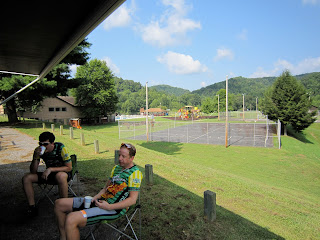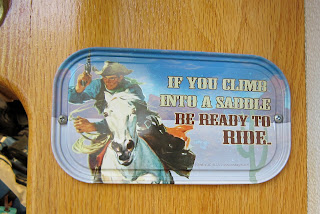Don't do something like this to see the country - if you do it, do it just to ride a lot. Too much time is spent riding to really enjoy what you're seeing.
Don't do it to have fun, it isn't much fun - but it is a major accomplishment. And is enjoyable, if not fun.
Remember, There aren't too many other things in life that we do every day, no interruptions, with some days being very hard - for 30 days straight. Every day. Did I mention - every day? Hard work? Every day.
Don't do it to meet a wide variety of people: many if not most of the people on a ride like this are so focused on riding that they don't have too much besides bicycling to talk about. And, your day is so tied up with riding, caring for the bikes, ingesting enough calories, that there isn't a lot of time for interacting with people.
If you want to "see" the country, plan on 60-80 miles per day - and plan your route to take in the history and the culture. And, leave time to visit the sights, and enjoy the people. And, take a day off every week or two.
The country is really big, and really interesting, and I wanted to stop and talk to folks, and see stuff and take side trips. Would like to do it again and take 2 months to do it - or do it in sections. Did I mention, the country is really big!
It isn't really that hard if you don't get competitive and go hammering along too much (though you can certainly do that at time: a few days we had great fun racing each other up each hill, and once I settled in, I did occasional days of hard intervals). Treat each day as a long but easy recovery ride and you'll go plenty fast enough, and have plenty of gas to complete each day sand be ready for the next.
Pacing came surprisingly naturally - I couldn't believe, on the first few days, my low heart rates. But that persisted, even when I consciously tried to go harder: my body just said "Dude, you're gonna be out here for 8 hours - 90 beats per minute will be just fine!"
I never really had any severe sore spots - just occasional twinges here and there (butt, knee) and for the long days on the plains, my neck was sore - not too unexpected considering the injury last fall. I never had any days where sagging was a consideration (Yes, I did EFI - Every Fabulous Inch), nor days where I felt like I was dragging to the finish (though some days, I treated the last hour or two as a very leisurely cruise), nor days when I felt like I might collapse of exhaustion or heat (heat was a significant issue for some people, not much of an issue for others including me).
Many folks entered and left this as a huge life event: desperately wanting to do EFM and disappointed if not successful. They got pretty emotional when they finished. It was a big enough deal that there were some tears at the finish, and about 15 families that had come in from all over the country to congratulate (Dad, son, husband, wife, etc) finishers.
9 of the clients were women - reportedly the largest group ever - of 38. Several on recumbents rode near the back - a function of the bike. Others rode near the later part of the pack. There were 2 hammerheads that rode hard and looked uncomfortable. And, the young Swiss woman would have buried 9 out of 10 of the men - but rode all day, every day, on the wheel of her partner who was the hammerheadiest of the hammerhead guys.
Youngest was 17 years (2nd transcontinental for him - and he was a license plate collector for a hobby). Oldest was 71. Many were quite overweight - tough in the hills, non-issue on the flats. One was using it as a fund raiser for diabetes research - pulled in $20,000.
There were 3-4 that hammered hard, were fast, and off the front every day - alone on their aerobars. There was a group of 5-6 that rode in a fast paceline at the front almost every day. The recumbents brought up the rear. And there were several groups of 3-5 that typically were just in front of the recumbents and rode pretty slowly most days - and some days, some of us from the middle would drop back to these groups and ride with them for a more relaxing pace, often taking major pulls for them. The rest of us rode either alone or in varying mixes of 3-5 person groups in the middle, often mixing and matching between and within days - riding alone at times, and joining forces as winds, paces, and tiredness dictated. Occasionally a stronger rider riding at a comfortable pace would pick up a few followers and pull them along for many miles to the benefit of all. (There were times when I felt strong, but didn't particularly want to go fast, and between 1 and 4 folks would latch onto my wheel and stay there for a long time. On the other hand when I wanted to go slow, I preferred to just get down on the aero bars and cruise along easy - I believe that I've roughly tripled my total lifetime experience on aerobars!)
I liked to ride with a pace line at times, but rode a majority of my time alone so that I could look around at the scenery and have more freedom to stop for a photo or to read a roadside sign.
iPods were prominent: some used them all day and rarely spoke. I liked to put on some tunes late in the day when groups tended to splinter, and I would choose music based on mood and pace. Never pulled it out before lunch.
Funny experience to get to 100 miles and say, glad that we've only got another 20 to go today.
Photography on the fly was prominent, and somewhat surprisingly, caused no mishaps - even when 38 people simultaneously reached into a rear pocket on the last day to photograph, on the move, the sunrise!
7 crashes on the trip, the rumble strip that several of us found on day 1, one high speed with a little concussion and a few lower speed tipovers including in the parking lots.
My laptop and Wikipedia and Google were great for reading up on towns we visited, and geology, and history, and culture. iPad would be even better. And, for a quick update, the Blackberry in my pocket with Google or Wikipedia gave me quick information when we stopped for breaks and lunch (and for keeping up with the TourdeFrance and World Cup during the first week).
The wood-framed master map that was carried along and updated daily, and signed by all at the end was auctioned off for charity at the end: $1100. Only Canadian and Australian bidders! Go figure.
A few practicalities:
I used mini clip-on aero bars. A life saver when riding alone both to gain a fraction of an MPH and save time in the saddle, and to rapidly abolish symptoms when the hands went numb. (Yes, a few people had bad enough neuropathies by the end that working on the bikes, changing tires, etc. were very difficult.)
Although Lon recommended standard wheels, many of us took aero wheels - lots of Ksyriums, and Dura-Ace in my case. I lucked out in that my spoke didn't break until the last 5 miles, but with spokes not really being field replaceable on these wheels, it would have been a real problem if it happened earlier - involving a FEDEX overnight delivery of a new wheel. If you ride a tour like this, use standard-spoked handbuilt wheels - and carry spare spokes.
Insulated water bottles are life savers!
Next summer, I'd like to do a transcontinental of Europe - any takers? Look at the Oriental Express on www.tourdafrique.com - Paris to Istanbul in 6 weeks.
Thanks to all who have read this stuff, who have posted comments, and who have expressed interest. I guess I'll go back to work now..
Sorry if today's post was TMI
This will be my last post unless I have some late epiphany.



























 Today's ride may have been the most consistently unvarying that I've ever done: flat, corn and soybeans, and small towns, over and over and over again.
Today's ride may have been the most consistently unvarying that I've ever done: flat, corn and soybeans, and small towns, over and over and over again.